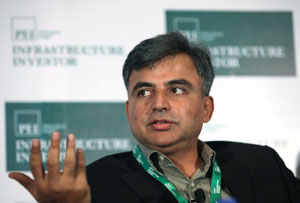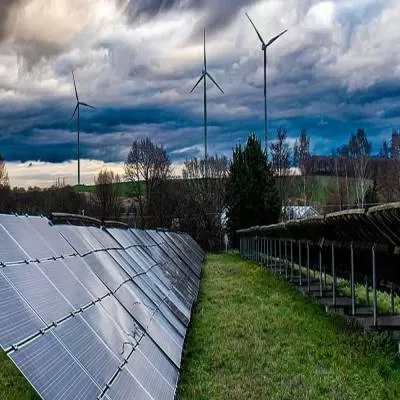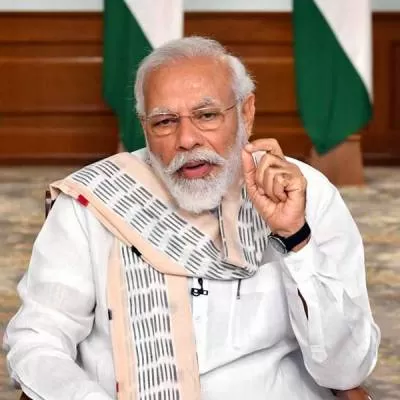- Home
- Infrastructure Transport
- ROADS & HIGHWAYS
- SIFL has Rs 15,000 crore in assets

SIFL has Rs 15,000 crore in assets
A pioneer in many ways, Srei Infrastructure Finance Ltd (SIFL) is among the first Indian NBFCs to access the international market for funds and the first Indian infrastructure NBFC to be listed on the London Stock Exchange. The company has also been certified as one of the six infrastructure finance companies (IFCs) by the Reserve Bank of India. The Government of India has declared SIFL as a 'Public Financial Institution'. These aspects have helped the company raise funds; its stakeholders include many international entities and funds that have given them lines of credit and funding. Shailesh Pathak, President-Corporate Strategy, Srei Infrastructure Finance Ltd, speaks to AHLAM RAIS about the current infrastructure financing scenario in India and lending portfolio.
Shed some light on the present infrastructure financing scenario in India.
India's infrastructure has seen a big improvement over the past 15 years. But, the past two years suggest that the challenge is not 'what to do' but 'how to do it' and 'how to finance it'. The bull-run years of 2003-2008 saw an aggressive financial sector looking at debt and equity opportunities in Indian infrastructure. In 2013, the scenario is not good and may not improve in the near future, until hard steps are taken.
The debt for infrastructure projects that came largely from public-sector banks has dried up, except for government and public-sector borrowers. Most lenders are apprehensive at the transition of their loans to corporate debt restructuring. This is dampening their appetite for fresh lending. Lenders now insist on many more risk-mitigating measures. Ultra-aggressive bids or, indeed, 'bid-and-win now, renegotiate later' strategies by private players are equally to blame. For equity finance, the situation is grim. Listed infrastructure stocks have seen large drops in share prices. Raising equity from primary markets is very different from, say, January 2008, which saw the largest-ever issue of a power company. Private equity (PE) is facing a troubled time. Most PE deals in infrastructure are under water. Several investors have seen the valuation of their investments decline alarmingly.
However, these issues relate to infrastructure projects during or before the construction phase. For infrastructure assets that are up and running and have cash flow visibility, the outlook is much more positive, and several deals have happened recently.
Elaborate upon your current lending portfolio. What are your offerings to the infrastructure sector?
Most of our asset portfolio comprises financing infrastructure companies. Under the RBI guidelines, for an IFC at least 70 per cent of our lending has to be to the infrastructure sector. Srei has a relationship with almost every single company in the infrastructure market. We offer the entire bouquet of financial services. We are customer-driven and our offerings are customised according to the requirements of the client. Our JV with BNP Paribas is the market leader in financing of ICE (Infrastructure and Construction Equipment) where we have a third of the market. Similarly, our JV with the Tata group has created Viom Networks, which is the largest independent tower company with 38,000 telecom towers.
Tell us about the support you have offered to important projects.
We have been involved in almost all major projects. For example, initially when the Delhi-Gurgaon expressway was being planned in 2002, nobody was ready to finance it. During this stage, HUDCO took the lead and we joined their consortium for financing the project. Apart from financing, we are the fifth largest highway developer in India, and currently operate 14 highways. We also have various other group companies that are into project development, across power transmission and distribution, seaport and airport development, SEZs and other sectors. We are a one-stop shop for infrastructure finance and development. With over 100 offices in India and abroad, Srei has the pulse of the market.
Which sectors do you lend maximum to and which ones do you avoid? What is the reason behind it?
The Government of India has come up with a revised list of infrastructure on March 1, 2012. There are five categories and within each category there are subsectors. The list includes diverse sectors such as transport, energy, water sanitation, communication, social and commercial infrastructure. We cover all these sectors and most of our financing is in the transport, energy and communication sectors. Now, we are increasing our financing in the water and sanitation, social and commercial infrastructure segments. Srei has built up excellent appraisal skills - so we can appreciate the risk in a particular project.There are no sectors to avoid, as long as one gets a good deal. A specific sector may not be bad; it is the individual deal that may be good or bad.
Recoveries of loans or Non Performing Assets (NPAs) are a major area of concern in the infra sector. What is Srei's performance in this regard? As we are a public financial institution as defined by law, we have the power to use 'Sarfesi' (Securitisation and Reconstruction of Financial Assets and Enforcement of Security Interest Act). Sarfesi empowers banks and asset reconstruction companies to carry out quick recoveries. Thanks to this, we have an advantage in recovering sticky loans. Most of our analysis is undertaken at the time of offering loans, so that there is no surprise later. With our appraisal skills and due diligence, Srei would minimise NPAs.
What are the challenges faced by lenders and what are your recommendations for reform?
For lenders, the fundamental challenge is lending to good projects of credible promoters. The advantage for Srei is that most promoters finance equipment from us. Hence, we know them well. This is an advantage that other pure lenders may not have. Indeed, the challenge before the infrastructure finance sector is to get construction moving, and for this, while the current slowing down of the economy does not reverse, initial kick-starting of construction projects should be carried out by the Government. Today, there are disputes over files and court cases because of which construction on ground does not happen.
What can an NBFC such as yours do to raise its lending profile vis-a-vis banks?
Banks can access lower cost deposits, which is their competitive advantage. In many ways, lending is all about the cost of money. The cheaper the cost of money, the lower your lending cost. Srei has also applied for a bank license.
In the event that Srei gets a bank licence, it is a great positive, since Srei is nimble, it knows the market and will have low cost deposits. After the bank licence, Srei can raise lower cost resources and lend at more competitive rates to any infrastructure project.
What is your current loan book like - faster or slow?
There is not much demand for fresh credit. The demand is largely for restructuring. Most lenders in India are perhaps not growing their loan book. Srei has been conservative and focused on cash flows and bottomlines. In the nine months of the current financial year, Srei has made a profit after tax (PAT) of Rs 134 crore.
To share your lending experience, write in at feedback@ASAPPmedia.com
Shailesh Pathak, President-Corporate Strategy, Srei Infrastructure Finance Ltd A pioneer in many ways, Srei Infrastructure Finance Ltd (SIFL) is among the first Indian NBFCs to access the international market for funds and the first Indian infrastructure NBFC to be listed on the London Stock Exchange. The company has also been certified as one of the six infrastructure finance companies (IFCs) by the Reserve Bank of India. The Government of India has declared SIFL as a 'Public Financial Institution'. These aspects have helped the company raise funds; its stakeholders include many international entities and funds that have given them lines of credit and funding. Shailesh Pathak, President-Corporate Strategy, Srei Infrastructure Finance Ltd, speaks to AHLAM RAIS about the current infrastructure financing scenario in India and lending portfolio. Shed some light on the present infrastructure financing scenario in India. India's infrastructure has seen a big improvement over the past 15 years. But, the past two years suggest that the challenge is not 'what to do' but 'how to do it' and 'how to finance it'. The bull-run years of 2003-2008 saw an aggressive financial sector looking at debt and equity opportunities in Indian infrastructure. In 2013, the scenario is not good and may not improve in the near future, until hard steps are taken. The debt for infrastructure projects that came largely from public-sector banks has dried up, except for government and public-sector borrowers. Most lenders are apprehensive at the transition of their loans to corporate debt restructuring. This is dampening their appetite for fresh lending. Lenders now insist on many more risk-mitigating measures. Ultra-aggressive bids or, indeed, 'bid-and-win now, renegotiate later' strategies by private players are equally to blame. For equity finance, the situation is grim. Listed infrastructure stocks have seen large drops in share prices. Raising equity from primary markets is very different from, say, January 2008, which saw the largest-ever issue of a power company. Private equity (PE) is facing a troubled time. Most PE deals in infrastructure are under water. Several investors have seen the valuation of their investments decline alarmingly. However, these issues relate to infrastructure projects during or before the construction phase. For infrastructure assets that are up and running and have cash flow visibility, the outlook is much more positive, and several deals have happened recently. Elaborate upon your current lending portfolio. What are your offerings to the infrastructure sector? Most of our asset portfolio comprises financing infrastructure companies. Under the RBI guidelines, for an IFC at least 70 per cent of our lending has to be to the infrastructure sector. Srei has a relationship with almost every single company in the infrastructure market. We offer the entire bouquet of financial services. We are customer-driven and our offerings are customised according to the requirements of the client. Our JV with BNP Paribas is the market leader in financing of ICE (Infrastructure and Construction Equipment) where we have a third of the market. Similarly, our JV with the Tata group has created Viom Networks, which is the largest independent tower company with 38,000 telecom towers. Tell us about the support you have offered to important projects. We have been involved in almost all major projects. For example, initially when the Delhi-Gurgaon expressway was being planned in 2002, nobody was ready to finance it. During this stage, HUDCO took the lead and we joined their consortium for financing the project. Apart from financing, we are the fifth largest highway developer in India, and currently operate 14 highways. We also have various other group companies that are into project development, across power transmission and distribution, seaport and airport development, SEZs and other sectors. We are a one-stop shop for infrastructure finance and development. With over 100 offices in India and abroad, Srei has the pulse of the market. Which sectors do you lend maximum to and which ones do you avoid? What is the reason behind it? The Government of India has come up with a revised list of infrastructure on March 1, 2012. There are five categories and within each category there are subsectors. The list includes diverse sectors such as transport, energy, water sanitation, communication, social and commercial infrastructure. We cover all these sectors and most of our financing is in the transport, energy and communication sectors. Now, we are increasing our financing in the water and sanitation, social and commercial infrastructure segments. Srei has built up excellent appraisal skills - so we can appreciate the risk in a particular project.There are no sectors to avoid, as long as one gets a good deal. A specific sector may not be bad; it is the individual deal that may be good or bad. Recoveries of loans or Non Performing Assets (NPAs) are a major area of concern in the infra sector. What is Srei's performance in this regard? As we are a public financial institution as defined by law, we have the power to use 'Sarfesi' (Securitisation and Reconstruction of Financial Assets and Enforcement of Security Interest Act). Sarfesi empowers banks and asset reconstruction companies to carry out quick recoveries. Thanks to this, we have an advantage in recovering sticky loans. Most of our analysis is undertaken at the time of offering loans, so that there is no surprise later. With our appraisal skills and due diligence, Srei would minimise NPAs. What are the challenges faced by lenders and what are your recommendations for reform? For lenders, the fundamental challenge is lending to good projects of credible promoters. The advantage for Srei is that most promoters finance equipment from us. Hence, we know them well. This is an advantage that other pure lenders may not have. Indeed, the challenge before the infrastructure finance sector is to get construction moving, and for this, while the current slowing down of the economy does not reverse, initial kick-starting of construction projects should be carried out by the Government. Today, there are disputes over files and court cases because of which construction on ground does not happen. What can an NBFC such as yours do to raise its lending profile vis-a-vis banks? Banks can access lower cost deposits, which is their competitive advantage. In many ways, lending is all about the cost of money. The cheaper the cost of money, the lower your lending cost. Srei has also applied for a bank license. In the event that Srei gets a bank licence, it is a great positive, since Srei is nimble, it knows the market and will have low cost deposits. After the bank licence, Srei can raise lower cost resources and lend at more competitive rates to any infrastructure project. What is your current loan book like - faster or slow? There is not much demand for fresh credit. The demand is largely for restructuring. Most lenders in India are perhaps not growing their loan book. Srei has been conservative and focused on cash flows and bottomlines. In the nine months of the current financial year, Srei has made a profit after tax (PAT) of Rs 134 crore. To share your lending experience, write in at feedback@ASAPPmedia.com























